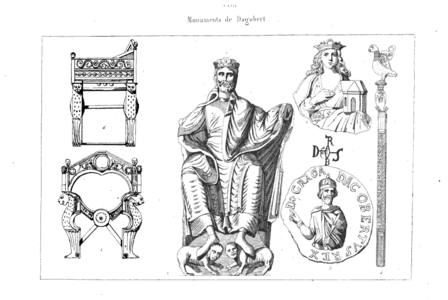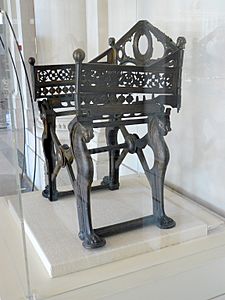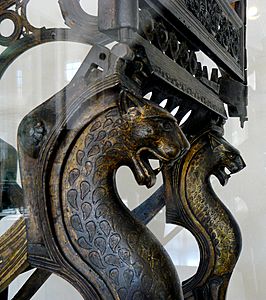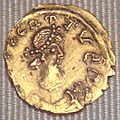Dagobert I facts for kids
Quick facts for kids Dagobert I |
|
|---|---|

Contemporary effigy of Dagobert from a gold triens
|
|
| King of Neustria and Burgundy | |
| Successor | Clovis II |
| King of the Franks | |
| Reign | October 629 – 19 January 639 |
| Predecessor | Chlothar II |
| Successor | Vacant (next held by Theuderic III) |
| King of Austrasia | |
| Reign | 623–634 |
| Predecessor | Chlothar II |
| Successor | Sigebert III |
| Born | c. 605/603 |
| Died | 19 January 639 (aged 35-36) Épinay-sur-Seine |
| Burial | Saint Denis Basilica, Paris |
| Spouse |
|
| Issue |
|
| Dynasty | Merovingian |
| Father | Chlothar II |
| Mother | Haldetrude |
| Signature | |
Dagobert I (born around 605/603 – died January 19, 639 AD) was an important Frankish king. He ruled over different parts of the Frankish kingdom during his life. First, he was king of Austrasia from 623 to 634. Then, he became king of all the Franks from 629 to 634. Finally, he ruled Neustria and Burgundy from 629 until his death in 639. Many historians see him as the last king from the Merovingian family who held true power. Dagobert was also the first Frankish king to be buried in the royal tombs at the Basilica of Saint-Denis.
Contents
Dagobert's Early Rule in Austrasia
Dagobert was the oldest son of Chlothar II and Haldetrude. His father, Chlothar, had been the sole ruler of all the Franks since 613. In 622, Chlothar made Dagobert king of Austrasia. This was likely done to keep the powerful nobles of Austrasia loyal to the main Frankish rulers. As a young boy, Dagobert was raised by important Austrasian leaders like Arnulf of Metz and Pepin of Landen.
His father, Chlothar, worked hard to keep peace with other noble families. When Dagobert first became king of Austrasia, some areas like Alsace were not included. But the Austrasian nobles soon made Chlothar give these regions to Dagobert. Dagobert even created a new duchy in southwest Austrasia. This area, later called the Duchy of Alsace, helped protect the region from neighboring groups. Dagobert appointed his trusted helper, Gundoin, as the first duke of this new area.
Uniting the Frankish Kingdoms
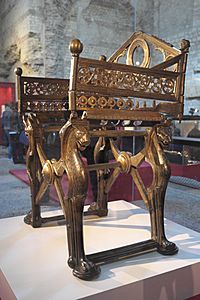
When his father died in 629, Dagobert took over the kingdoms of Neustria and Burgundy. His half-brother, Charibert II, also wanted to rule Neustria. Dagobert did not agree to this. Charibert's uncle tried to speak for him, but Dagobert had him removed. Dagobert then became the sole king of all the Franks. He later gave Aquitaine to Charibert as a smaller kingdom to rule.
In 629, Dagobert made an agreement with the Byzantine emperor Heraclius. This agreement included making sure that all Jewish people in his kingdom were baptized. Dagobert also worked to make trade safer across his empire. He protected important markets near the Rhine river, which helped his kingdom's economy.
Frankish society became more unified under Dagobert and his father. The Catholic faith became very important, and the economy generally improved. Dagobert was known for being wealthy. For example, he helped the Visigothic king Sisenand come to power in Spain. In return, Sisenand gave Dagobert a large golden dish.
When Charibert and his son were killed in 632, Dagobert gained full control of Burgundy and Aquitaine. This made him the most powerful Merovingian king in many years. In 631, Dagobert led a large army against Samo, the ruler of the Slavic Wends. This was partly because the Wends had robbed Frankish merchants. Dagobert's Austrasian forces were defeated in a battle, but his allies from other regions were more successful.
Ruling from Paris
Also in 632, some nobles in Austrasia rebelled against Dagobert. To calm them down, Dagobert put his three-year-old son, Sigebert III, on the throne of Austrasia in 634. This meant Dagobert gave up some of his power in the eastern part of his kingdom. This decision had a big impact on how the Merovingian kingdom would be structured in the future.
As king, Dagobert made Paris his main capital city. During his rule, he built the Altes Schloss in Meersburg, which is now the oldest inhabited castle in Germany. Dagobert was also very religious. He was responsible for building the Saint Denis Basilica in Paris, which was a Benedictine monastery. He also appointed St. Arbogast as bishop of Strasbourg.
Many people liked Dagobert. A writer named Fredegar said that Dagobert "gave justice to rich and poor alike." He also wrote that Dagobert "took little sleep or food, and cared only so to act that all men should leave his presence full of joy and admiration." Historians believe that Dagobert and his father, Chlothar, ruled during a time when the Merovingian kings had a lot of power.
Dagobert is remembered as one of the greatest Frankish kings. He managed to keep his lands safe from threats from the east. Even nobles in far-off Bavaria looked to him as their overlord. Dagobert died when he was only 36 years old. Most historians consider him the last truly powerful Merovingian king. He was buried in the abbey of Saint Denis Basilica in Paris. This set a tradition for future French rulers to be buried there.
Dagobert's Legacy
The way Dagobert's kingdom was divided and how power was passed down continued for about a century. Eventually, Pepin the Short removed the last Merovingian king in 751. This led to the start of the Carolingian dynasty. After Dagobert, many Merovingian kings were very young when they inherited the throne. Real power often rested with powerful noble families who controlled most of the land.
In the 830s, a book about Dagobert called the Gesta Dagoberti was written. It's not always accurate, but it does contain some true information. Dagobert is also famous from a French nursery rhyme called Le bon roi Dagobert (The Good King Dagobert). This song makes fun of the king and shows his chief adviser, Saint Eligius, giving him good advice. The song probably started in the 1700s and became popular during the French Revolution. It's not historically accurate, but it's a fun way people remember Dagobert.
In 1984, a French-Italian comedy movie called Le bon roi Dagobert was made, based on Dagobert I.
Marriage and Children
Dagobert I had several wives and children. According to historical records, he had three queens at different times.
- In 625 or 626, Dagobert married Gormatrude. She was the sister of his father's wife. They did not have any children.
- After divorcing Gormatrude around 629 or 630, he married Nanthild. She was a servant in his household. Nanthild gave birth to Clovis II, who later became king of Neustria and Burgundy.
- Around the same time as his marriage to Nanthild, a woman named Ragnetrude had a son with Dagobert I. This son was Sigebert III, who later became king of Austrasia.
Some historians have suggested that Regintrud, an abbess, might also have been Dagobert I's child. However, this idea doesn't fit with her supposed birth date.
Dagobert's Coins and Treasures

Treasures of Dagobert
-
Treasures of Dagobert - Abel Hugo - France historique et monumentale (1837).
Coinage
-
Triens of Dagobert I, Uzès, 629–639, gold 1.24g. Monnaie de Paris.
-
Solidus of Dagobert I, Marseille, 623–629. Cabinet des Médailles.
See also
 In Spanish: Dagoberto I para niños
In Spanish: Dagoberto I para niños



